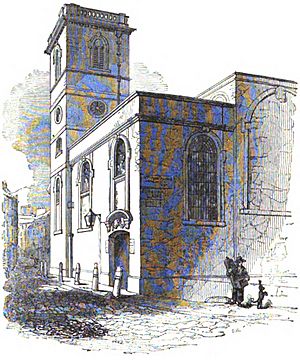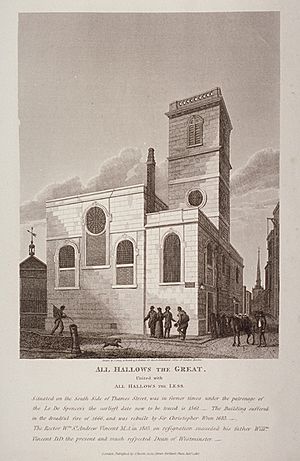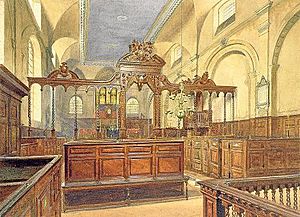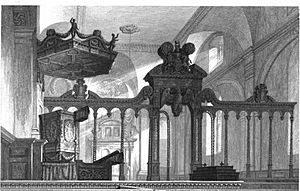All-Hallows-the-Great facts for kids
Quick facts for kids All-Hallows-the-Great |
|
|---|---|
 |
|
| Location | Upper Thames Street, London |
| Country | United Kingdom |
| Denomination | Anglican |
| Architecture | |
| Architect(s) | Christopher Wren |
| Style | Baroque |
| Demolished | 1894 |
All-Hallows-the-Great was an old church in the City of London. It was located on what is now Upper Thames Street. People first wrote about this church in 1235.
Sadly, the church was destroyed in the terrible Great Fire of London in 1666. After the fire, it was rebuilt by the team of Sir Christopher Wren, a famous architect. All-Hallows-the-Great was taken down in 1894. Many bodies from its churchyard were moved and reburied at Brookwood Cemetery.
Contents
A Look at its History
All Hallows means "All Saints." This church was one of eight churches in London with the same name. Its full name, All-Hallows-the-Great, helped people tell it apart from another church nearby called All-Hallows-the-Less.
The oldest mention of the church is from 1100-1107. It was called Omnium Sanctorum in London quae dicitur Semannesire. This means "All Saints that is called Seamen's church, in London." Other old records used names like All Hallows the More or All Hallows Thames Street. It was also called All Hallows in the Hay or All Hallows in the Ropery. This was because hay was sold at a nearby wharf and ropes were made on the high street.
All-Hallows-the-Great was also important for the German community living nearby. These German merchants were part of the Hanseatic League. They had a small chapel, but the church was their main place of worship. The church was quite large. It even had a big cloister (a covered walkway) and a grammar school. King Henry VI started this school in 1447.
The Church During the Commonwealth
During a time called the Commonwealth, All-Hallows-the-Great became a meeting place for a group called the Fifth Monarchy Men. This group believed that a new, holy kingdom was coming soon. They thought the execution of King Charles I and the year 1666 were signs of this new kingdom.
The ideas of this group were quite strong. A famous writer, Samuel Pepys, wrote about them. He noted that they put up the Royal coat of arms of Charles II a month before the king returned to power. After the king came back, the church members asked to keep their current leader, Robert Bragge. They said he was "sound in doctrine and of a holy conversation."
Rebuilding After the Great Fire
After the Great Fire destroyed the church, its area was joined with that of All-Hallows-the-Less. In 1669, the two church groups built a temporary building. This was in the churchyard of All-Hallows-the-Great. They held services there while the main church was being rebuilt.
This temporary building was one of 27 "tabernacles" built in London after the fire. Money for these came from a special tax on coal. Some churches took a very long time to rebuild. For example, St Mary Somerset and St Andrew-by-the-Wardrobe took 22 years! All-Hallows-the-Great was rebuilt between 1677 and 1684. It cost about £5,641. Later, a watch house was built in the churchyard. This was to stop grave robbers.
The Church's Final Years
By the 1700s, Thames Street was very busy. Carts passing by almost touched the church's north wall. As time went on, more people moved out of the City of London to the suburbs. The City became more of a workplace.
In 1876, the church's tower and north side were taken down. This was to make Upper Thames Street wider. A new tower was built on the south side. But in 1894, the rest of the church was demolished. Its furniture and decorations were moved to other churches. The church's area was then combined with St Michael Paternoster Royal. The land was sold for £13,129. This money was used to build a new church called All Hallows in Gospel Oak.
A brewery was built on the church's old site. This brewery was destroyed during the Second World War. The churchyard and the rebuilt tower lasted until 1964. Then, a large telephone exchange called Mondial House was built there in 1975. It was the biggest telephone exchange in Europe. Mondial House was torn down in 2006 to make way for new office buildings.
Church Design and Features
The church building was a slightly uneven rectangle. Its north and west sides were visible from the outside. The outside of the church was quite plain. Many visits by Robert Hooke suggest he might have designed it.
The church's original tower survived the Great Fire. Even before the church was rebuilt, melted bell metal from the ruins was used to make a new bell. This bell was put in the old tower in 1671. However, the fire had damaged the tower more than people thought. So, it was taken down and rebuilt in 1684. The new tower was simple, with rounded windows and a decorative railing.
The church leaders wanted Sir Christopher Wren to add a dome or spire to the tower. They said it "stands conspicuous to the Thames." But this plan never happened.
All-Hallows-the-Great had many beautiful furnishings inside. Many of these pieces are still in other churches today. It was one of only two churches designed by Wren to have a special screen called a rood screen. The church members ordered it after seeing one in another church. This screen is now in St Margaret Lothbury.
When it was finished, All-Hallows-the-Great was the only Wren church with statues that were not memorials. These life-sized statues of Moses and Aaron stood next to the Ten Commandments. They are now in St Michael Paternoster Royal. That church also received the lectern (a stand for reading, which is now missing) and a chandelier from All-Hallows-the-Great. The old pulpit from All-Hallows-the-Great is now in St. Paul's Hammersmith.
Images for kids








